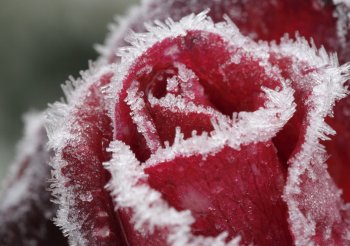
Coping Through the Winter Months
Chris Smellie, NZFGA
Recently I had a conversation with prominent Auckland flower marketer. He expressed considerable concern about the quality of NZ flowers being sold over the May/June period and how they were not comparing well against imports at this time. He felt that the growers needed to take a lot more care with their product especially as buyers choose quality over price every time.
Growing Conditions
It has always seemed to me that NZ growers are at a particular disadvantage as we move into the difficult autumn months for growing, while northern hemisphere growers move into the excellent conditions of spring. Or those growing at elevated equatorial sites also have favourable conditions.
I wondered if conditions this autumn had been more difficult than usual, especially as one report I had seemed to indicate this. I contacted ‘Met Service’ who passed me on to ‘Niwa’ for comparative conditions. With the help of a climate scientist we looked at records for April/May & June to date from recordings at Mangere and Warkworth.
While the average Relative Humidity was down for May 2016 compared with May 2015, this does not tell the whole story. May 2016 was the hottest May on record by about 2 degrees. The reason for this relates to warmer seas than usual to the west of NZ and more north westerly winds than usual as well. So the airflow has been warm and moist, with a lot more moisture able to be carried in the warmer air in terms of ‘vapour pressure’ or absolute water content. This has meant that whenever there has been a temperature drop there has been a lot of humidity and large dumps of water.
Conditions to date through June have been closer to what they were last year but then both 2015 & 2016 temperatures have been well above the 30 year average. At winter solstice this year, temperature highs were more like those of mid April than late June, based on the 30 year average.
While not conclusive, there is an indication here of weather conditions being more difficult than our normal autumn conditions.
Whilst looking at the ’Niwa’ site I also noticed that the ‘Barring Head’ recording station which overlooks Cook Straight and has the longest running CO2 record for the southern hemisphere, officially passed the 400ppm of CO2 in the atmosphere reading during the week of the shortest day.
Managing In Heated Houses.
Managing adverse growing conditions is much easier if you have a growing environment in which the grower has reasonable control of humidity and temperature, although there can still be trip ups.
There have been numerous articles in the ‘Weekly Information’ about humidity control and heating, some of the links are below many of which would be useful for both heated and unheated houses.
-
Excellent internal ventilation fan http://www.hortidaily.com/article/26521/New-ventilator-offers-50-procent-less-noise-and-40-procent-less-energy-consumption
-
Advantages of heating the plant root zone http://www.floraldaily.com/article/5351/Efficiently-heating-a-greenhouse-in-winter
-
Simple wireless data loggers to monitor greenhouse environment http://www.hortidaily.com/article/26140/Wireless-dataloggers-manage-temp-&-humidity-in-greenhouses
-
Use of internal air circulation fans. http://www.hortidaily.com/article/25987/Setting-up-horizontal-airflow-fans-to-help-prevent-diseases
-
Air Mixing above screens http://www.hortidaily.com/article/25324/Take-advantage-of-air-above-the-screen-to-regulate-humidity
-
Air movement around plants http://www.hortidaily.com/article/25335/Understanding-the-boundary-layer
-
Concepts in dealing with humidity
http://www.floraldaily.com/article/4308/Finnish-grower-recoups-the-energy-stored-in-excess-humidity -
Detailed discussion on humidity.
http://www.hortidaily.com/article/24779/How-does-humidity-influence-crop-quality -
Screen & fan manipulation to combat humidity
http://www.floraldaily.com/article/4067/Netherlands-Jet-Ventilation-system-further-optimized-in-gerbera-cultivation -
Botrytis Control http://www.floraldaily.com/article/4028/In-search-of-new-methods-to-control-gray-mold
-
Australian company devises a capture system for managing heating/cooling & humidity in greenhouse http://www.hortidaily.com/article/26327/Australia-Toyesi-introduces-PCVER-system
Managing in Unheated Situations
As mentioned before this is more difficult and various growers have different approaches. I have some feedback from three growers around Auckland.
-
An experienced cold house grower of 30 years, thought it has been the most difficult autumn in his experience. He is spraying for botrytis up to four times a week and flower grading is taking him twice as long as usual.
-
Also an experienced cold house grower of many years; agrees it has been a difficult autumn season, he stressed dryness in the greenhouse – no roof leaks etc. and ran a dry irrigation. He also keeps his house vented all the time. He found that if there was no insect damage on the flowers then no botrytis. He did not spray for botrytis but did use Foschek consistently which is good at ramping up plant defences and helps prevent Downy mildew of which he had had a little bit. Overall he was happy as the warmer weather had given him extra production.
-
A situation where Downy mildew had been bad and therefore botrytis had been bad as well. Grower used Metalyxl based fungicides both sprayed on & drenched and this seemed to be effective.
The Other side of the story is that sales are often sluggish during the winter months. The’ National Flower Promotion Group’ are running a special campaign to combat the slower winter sales entitled “Turn Flowers into Paris”




 Classifieds
Classifieds

